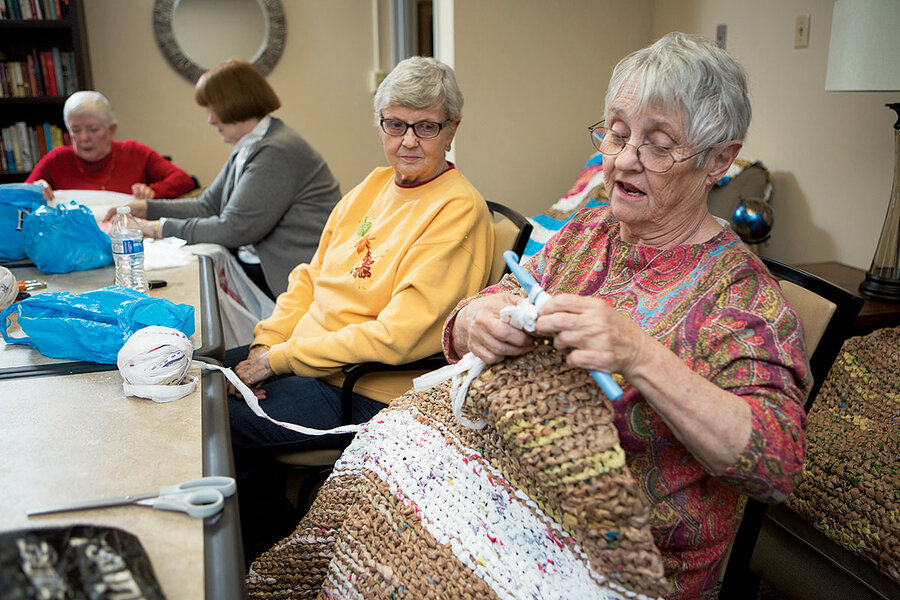How these women crochet sleeping mats for homeless people out of plastic bags
Loading...
| Milton, Mass.
About a dozen women from Winter Valley senior housing in Milton, Mass., have been meeting almost every week for more than a year. Gathered around a table, they’re converting plastic bags into water-resistant mats for homeless people. The finished mats are spongier and more resistant than cardboard, helping to protect people from the effects of lying on the cold, hard ground. The Winter Valley women are part of a larger mat-making project that began in 2016 with a church group in Union City, Tenn., and has been adopted by groups from California to Iowa to Canada. It’s also been shared widely on Facebook, which is how Winter Valley resident Judy O’Brien learned about it. At first, the women in Milton asked for plastic bags on a Facebook group page for the town’s residents. Now, the mat-making project is so well known in Milton that people drop off boxes of bags at Winter Valley and fill resident Lea Cullen’s car – which she leaves unlocked – with more bags. “I think [we’ll stop crocheting only] when they ban plastic bags,” says Ms. O’Brien.
Why We Wrote This
Usually, plastic bags are solely utilitarian, and more and more, they’re maligned. But residents in Milton, Mass., are creating something eye-catching out of them – and humane.
On Wednesdays at 6:30 p.m., women from Winter Valley senior housing in the Boston suburb of Milton, Mass., gather around a table to chat, snack on baked goods, and crochet. Except these women aren’t making hats and scarves out of soft yarns. They’re creating sleeping mats for homeless people – out of recycled plastic bags.
This particular group of about a dozen women has been meeting almost every week for more than a year, converting bags into six-foot-long water-resistant mats. The finished mats are delivered to Pine Street Inn, a service center in Boston for homeless people. They’re spongier and more resistant than cardboard, helping to protect people from the effects of lying down on the cold, hard ground. So far, the Winter Valley women have delivered 16 mats.
The mats are “really helpful because they keep people off the concrete, and part of preventing frostbite is keeping people dry. That mitigates against cold weather injuries, so [they’re] lifesavers,” says Michael Andrick, director of outreach at Pine Street Inn.
Why We Wrote This
Usually, plastic bags are solely utilitarian, and more and more, they’re maligned. But residents in Milton, Mass., are creating something eye-catching out of them – and humane.
Not the only mat-makers
The Winter Valley women are part of a larger mat-making project that began in 2016 with a church group in Union City, Tenn., and has since been adopted by groups from California to Iowa to Canada. It’s also been shared widely on Facebook, which is how Judy O’Brien, a Winter Valley resident fondly referred to as the “boss lady,” learned about it. The only problem: She didn’t know how to crochet. So she recruited friend and neighbor Edith Johansen to teach a few other women, and the Milton chapter was born. (Ms. Johansen, who holds a record by having completed five mats, has been temporarily sidelined by a hand injury, but still attends meetings to boost morale.)
The project has emerged at a time when more than half a million people in the United States are homeless. Although Boston’s homeless population is significantly smaller than those in other US cities – less than 1 percent of the Boston population is homeless – those who sleep outside in Boston endure brutal New England weather. The plastic mats are one way to provide a measure of comfort to the city’s homeless community, and it’s also giving the crocheters a sense of purpose.
“It’s kind of fun, and you meet all of your neighbors, and then you get to give back,” says Sheila McLelland as she works on her first mat. Despite not having crocheted for 30 years, Ms. McLelland deftly pulled and looped the material with ease. “I think that it’s nice, because when it’s cold out, [homeless people] don’t have to sleep on the cold ground.”
Pine Street Inn, which sweeps the streets on the coldest nights to bring people inside, enlists overnight teams to deliver the mats. Members of the homeless community have consistently expressed their gratitude for the mats, recognizing the crocheters for their hard work, Mr. Andrick says.
Each 120-row mat is made up of 500 to 600 bags and takes about a month to make. The bags are folded, cut, and looped to create “plarn,” or plastic yarn. The result is a unique, multicolored mat that can be easily rolled up and is light to carry. Attached to the mats are warning labels that caution against placing them on top of heating vents, where they could melt and catch on fire. (The labels were added after one of the crocheters accidentally left a mat next to a radiator for too long.)
While the mat-making project is ensuring that homeless people will be warmer as they sleep, it has also helped the women of Winter Valley get out of their apartments and meet new people.
“In the winter, the nights are long and you get tired of TV.... There’s only so much you can watch,” says Marie Butler as Ms. O’Brien brings out a tray of chocolate frosted cookies. “I enjoy the company. We get along well, all of us, because we’re all friends.”
Chitchat while crocheting
In fact, many of the women met each other and became friends through the project. As they crochet, they ask each other about their days, their family members, and whether they plan to attend a pancake breakfast the next morning.
When the women started crocheting, they asked for plastic bags on a Facebook group page for Milton residents. Now, the mat-making project is so well known in town that people drop off boxes of bags at Winter Valley and fill resident Lea Cullen’s car – which she leaves unlocked – with more bags.
“I will go to church [on Sundays], and by the time I come to drive back home, the back of my car is full of bags,” says Ms. Cullen with a shrug as the women around her break out in laughter. Cullen, who was the only woman engineer in her class at Northeastern University in the 1950s, doesn’t crochet herself but still enjoys watching her friends transform bags into mats.
Some of the bags that the women receive can’t be used because they’re ruined or made from a thicker kind of plastic that isn’t flexible enough to be crocheted, O’Brien says.
Whether or not the bags can be used for the mats, the women recycle almost everything they receive. And they show no signs of slowing down.
“I think [we’ll stop crocheting only] when they ban plastic bags,” says O’Brien with defiance.








